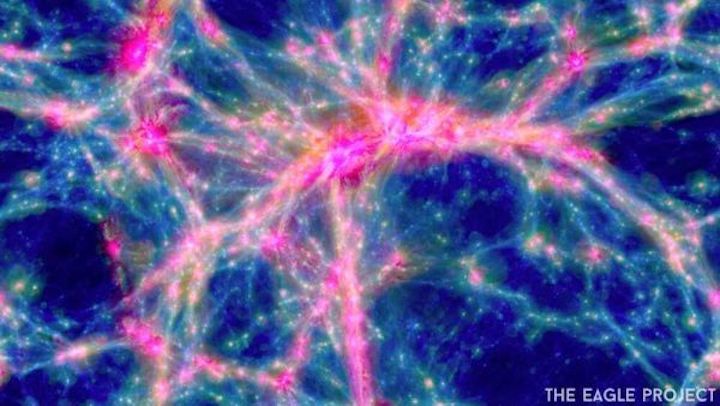The universe is permeated by a vast, invisible web, its tendrils weaving through space. But despite organizing the matter we see in space, this dark web is invisible. That's because it is made up of dark matter, which exerts a gravitational pull but emits no light.
That is, the web was invisible until now. For the first time, researchers have illuminated some of the darkest corners of the universe.
Weaving the web
A long time ago, the universe was hotter, smaller and denser than it is now. It was also, on average, much more boring. There wasn't much variation in density from place to place. Sure, space was much more cramped overall, but in the young universe, no matter where you went, things were pretty much the same.
But there were tiny, random differences in density. Those nuggets had slightly more gravitational pull than their surrounding neighborhood, and so matter tended to flow into them. Growing bigger in this way, they developed an even stronger gravitational influence, pulling more matter in, causing them to be bigger, and so on and so on for billions of years. Simultaneously, as the nuggets grew, the spaces between them emptied out.
Over the course of cosmic time, the rich got richer and the poor got poorer.
Eventually, the dense patches grew to become the first stars, galaxies and clusters, while the spaces between them became the great cosmic voids.
Now, 13.8 billion years into this massive construction project, the job isn't quite finished. Matter is still streaming out of the voids, joining groups of galaxies that are flowing into dense, rich clusters. What we have today is a vast, complex network of filaments of matter: the cosmic web.
A light in the dark
The vast majority of matter in our universe is dark; it does not interact with light or with any of the "normal" matter that we see as stars and gas clouds and other interesting things. As a result, much of the cosmic web is completely invisible to us. Fortunately, where the dark matter pools, it also drags along some regular matter to join in the fun.
In the densest pockets of our universe, where the gravitational whispers of dark matter have influenced enough regular matter to coalesce, we see light: The regular matter has converted itself into stars.
Like a lighthouse on a distant, black seashore, the stars and galaxies tell us where the hidden dark matter lurks, giving us a ghostly outline of the cosmic web's true structure.
With this biased view, we can easily see the clusters. They pop out like giant cities seen from a red-eye flight. We know for sure there's a tremendous amount of dark matter in those structures, since you need a lot of gravitational oomph to pool together that many galaxies.
And on the opposite end of the spectrum, we can easily spot the voids; they are the places where all the matter isn't. Because there are no galaxies to illuminate these spaces, we know that they are, by and large, truly empty.
But the grandeur of the cosmic web lies in the delicate lines of the filaments themselves. Stretching for millions of light-years, these thin tendrils of galaxies act like great cosmic freeways crossing black voids, connecting bright urban clusters.
Through a dim lens
Those filaments in the cosmic web are the hardest part of the web to study. They have some galaxies but not a lot. And they have all sorts of lengths and orientations; in comparison, the clusters and voids are geometric child's play. So, even though we've known of the existence of filaments, through computer simulations, for decades, we have had a hard time actually, you know, seeing them.
Recently, though, a team of astronomers made a major advance in mapping our cosmic web, publishing their results Jan. 29 to the arXiv database. Here's how they went to business:
First, they took a catalog of so-called luminous red galaxies (LRGs) from the Baryon Oscillation Spectroscopic Survey (BOSS) survey. LRGs are massive beasts of galaxies, and they tend to sit in the centers of dense blobs of dark matter. And if the LRGs sit in the densest regions, then lines connecting them should be made of the more delicate filaments.
But staring at the space between two LRGs isn't going to be productive; there isn't a lot of stuff there. So, the team took thousands of pairs of LRGs, realigned them and stacked them on top of each other to make a composite image.
Using this stacked image, the scientists counted all the galaxies that they could see, adding up their total light contribution. This allowed researchers to measure how much normal matter made up the filaments between the LRGs. Next, the researchers looked at the galaxies behind the filaments, and specifically, at their shapes.
As light from those background galaxies pierced the intervening filaments, the gravity from the dark matter in those filaments gently nudged the light, ever so slightly shifting the images of those galaxies. By measuring the amount of shifting (called "shear" by the scientists), the team was able to estimate the amount of dark matter in the filaments.
That measure lined up with theoretical predictions (another point for the existence of dark matter). The scientists also confirmed that the filaments weren't entirely dark. For every 351 suns' worth of mass in the filaments, there was 1 suns' worth of light output.
It's a crude map of the filaments, but it's the first, and it definitely shows that while our cosmic web is mostly dark, it's not completely black.
Quelle: SC


